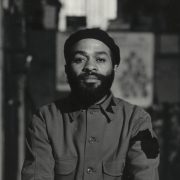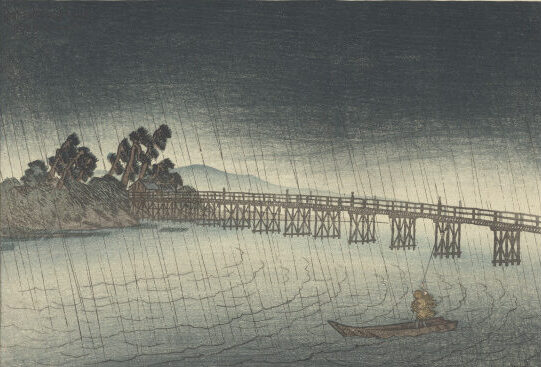Ted Joans


Search for art, find what you are looking for in the museum and much more.

Explore the ancient Japanese province of Omi through the woodblock prints of artist Ito Shinsui, a pioneer of modern Japanese prints.
Welcome to an online presentation of the exhibition Eight Views of Omi: Japanese Woodblock Prints by Ito Shinsui on view in the Works on Paper gallery through July 9, 2023. More information about the exhibition can be found on the exhibition page.
Ito Shinsui was a pioneer of modern Japanese prints known as shin-hanga (new prints), a traditional woodblock printmaking technique that emphasized collaboration between the artist, publisher, block carver, and printer.
Born in Tokyo, Ito Shinsui began apprenticing with printmaking master Kaburagi Kiyokata at age 13. In 1915, Shinsui designed one of the first shin-hanga prints, and three years later, he created Eight Views of Omi, which was produced by the publisher Watanabe Shozaburo. Known for its natural wonders, temples, and shrines, Omi is an ancient Japanese province situated around Lake Biwa near Kyoto. Since the Heian period, Omi had attracted emperors, imperial families, and noblemen for retreat and exile from the outside world.
Featured here is the complete set of Shinsui’s Eight Views of Omi, alongside some of his other works, which were donated to VMFA by patrons René and Carolyn Balcer. The Balcers have also given the museum hundreds of prints by Kawase Hasui, another leading artist of shin-hanga in the first half of the 20th century.
This landscape by Shinsui depicts a portion of the Hira Mountains, west of Lake Biwa, which run nine miles from north to south. The range experiences hard winters each year and is famously depicted covered in snow in the dark of night. This print, however, shows an early spring scene with snow melting on the foothills and reeds swaying in the wind on the water bank. A brown gradation defines the evening sky, and the transition from blue to brown on the water indicates the reflections of the mountains and the sky.
Known as the “floating temple,” Ukimodo is a humble Buddhist hall standing on wooden supports over Lake Biwa in Shiga Prefecture. It was first constructed as part of Mangetsuji, a Zen Buddhist temple, during the Heian period (794–1185). Here, Shinsui depicts an evening scene of Ukimodo, connected by a bridge from the shore, with a snow-capped pine tree on the bank and reeds in the frozen water. The falling snowflakes convey a sense of tranquility and mystery. This site is known for the often-depicted scene of “descending geese at Katada,” a poetic theme that was adopted by many artists in paintings and prints.
For more than a thousand years, a gigantic pine tree has stood on Krasaki, a small cape on the west bank of Lake Biwa. Its disproportionately wide branches extend more than 200 feet across. Wooden poles have been erected to support the branches and help protect them against the effects of weather. Shinsui presents a cropped view of the pine’s deformed heavy trunk, using shade gradations to render tree barks. In contrast, young trees planted nearby are visible in the distance. In Japan, the pine tree symbolizes life, longevity, and the spirit of its people.
The Miidera Temple is located at the foothills of Mount Hiei in Otsu, a short distance from Kyoto. The name Miidera was derived from a natural hot spring, where Emperors Tenchi and Tenmu and Empress Jito received their first ritual baths as newborn infants in the 7th century. Here, Shinsui has illustrated a close-up, cropped view of the Moon Viewing Stage by a temple hall, accompanied by a pine tree bending in the storm. The vertical lines define the heavy rain, and the use of light and shadow creates a misty atmosphere. A small bell hanging from the roof evokes a large bell housed in the temple, as well as the phrase “the evening bell of Miidera.”
This landscape depicts a view of Awazu, a picturesque town located on the southern shore of Lake Biwa. Awazu is on the Tokaido, an ancient highway that linked Tokyo to Kyoto during the Edo period (1615–1868). In this view, Shinsui indicated clearing weather with white clouds shown against a blue sky. In the middle ground a farmer plows the rice field with a cow, while pine trees line the picture plane against the distant mountain. Only the vast land in the foreground conveys the history of Awazu as the site of the Battle of Awazu in 1184 during the Genpei War.
The Ishiyama Temple is a Shingon Buddhist temple located on the hillside by the Seta River, south of Lake Biwa. The temple was founded in the 8th century and dedicated to Kannon, the Bodhisattva of Compassion. In the Heian period (794–1185), it attracted emperors, royal families, and nobles from Kyoto for worship and prayer. Here, Shinsui presents an evening view of a humble temple hall atop a thatched roof standing by a pine tree, while a full moon and shining stars dot the dark sky. Legend told that Murasaki Shikibu conceived the concept of the Tale of Genji during her stay at the temple in 1004.
This seascape depicts a wooden bridge that crosses the Seta River on the south end of Lake Biwa. In the Chronicles of Japan published in 720, the bridge is referred to as Seta Bridge or Long Bridge. For centuries, it was the only bridge across the Seta River from the East region to Kyoto, thus becoming a military target in wartime. It has been burned many times throughout its history. This print illustrates the bridge after it was rebuilt by warlord Oda Nobunaga (1534–1582) in 1600, with an arched deck with railing and a truss framework. In the picture’s foreground, a lonely fisherman sails on the trembling water. Shinsui used dark colors to define the evening sky and diagonal lines to describe the storm, with only the subtle blue gray on the distant mountains softening the dark evening.
This seascape captures the evening glow at Yabase, an ancient harbor on the east shore of Lake Biwa. During the Edo period (1615–1868), boats transported passengers and goods between Yabase to Otsu, a station on the Tokaido Road near Kyoto. Instead of the steamers that had appeared in Japan during the early Meiji period (1868–1912), Shinsui chose to depict small wooden boats sailing against a gust of wind toward the shore—a lyrical genre known as “fishing boats returning in the evening.” A predominant pink wash on the surface makes this print unique in the series, as the only one to incorporate a vibrant, warm color.